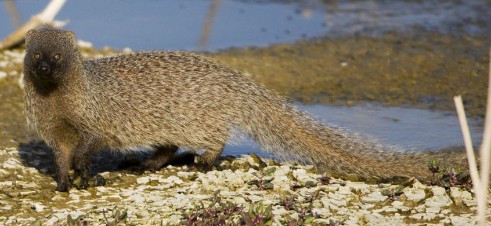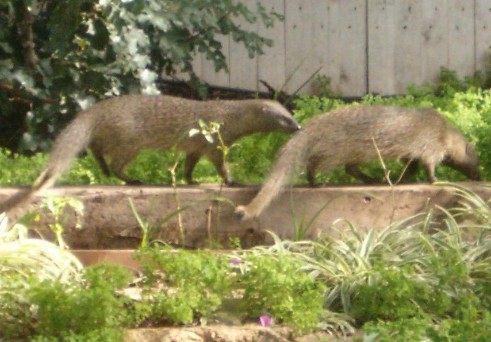Mammals in the order Carnivora are divided into two suborders, the dog like (Caniformia) and the cat like (Feliformia). Mongooses are part of the Feliformia and most are in the family Herpestidae, including the Egyptian mongoose (Herpestes ichneumon) which is the only species of mongoose present in Israel. This species lives in non-desert habitats in most of Africa, southern Spain, and east through out Israel and Egypt. In Israel they are common wherever there is water.
For years I saw grey, slinky animals walk by, sometimes in pairs or sometimes in a group of one adult, which I assumed was the mother, and several young. Embarrassingly for all those years I didn’t know what species of mammal I was observing. It was only last year when I studied a ‘Mammals of Israel’ poster that I realized I had been watching what for me is almost a mystical animal; the heroic, viper killing mongoose made famous by Rudyard Kipling in his story Rikki-Tikki-Tavi.
Rina Ben-Yaacov working with Dr. Yoram Yom-Tov of Tel Aviv University studied the behavior of Egyptian mongooses for several years. Her study concentrated on two family groups living in the area of Kibbutz Ma’agen Michael. By watching them consistently and by feeding the animals at the beginning of the study she managed to acclimate them to her presence. In this way Ben-Yaacov was able to recognize individuals and observe intimate details of their interactions.
She found that mongoose families live in territories with their boundaries marked by family dung hills. The families were polygynous, made up of several females, one male, and their offspring. The females in these groups cooperated in caring for the cubs. Ben-Yaacov watched them nursing not only their own cubs but also the cubs of other females in the group. She also saw the females feed prey to older cubs that were not their own, and that all the females and sometimes even the male helped to lead the cubs when they were old enough to prowl through their territory. So the adult mongoose that I saw leading cubs might not necessarily have been the cub’s mother.

Egyptian mongoose, Herpestes ichneumon, picture taken in Israel by Eyal Bartov.
Another study by Dr. Palomares and Dr. Delibes on the social behavior of Egyptian mongoose living in Spain did not show the same polygynous family structure. Palomares and Delibes never found females living together. In their study, the mongoose were mostly recorded alone except during the spring when cubs were with their mothers. The authors speculate that Egyptian mongoose have a flexible social structure: dependable food supplies allow the mongooses to be more social than when food is scattered and harder to find. This is similar to the behavior of Golden Jackals which live in small family groups when food is scattered but in larger packs when there is a single dependable food source.
Ben-Yaakov examined the fecal remains of the mongoose families she studied and found that they ate a variety of prey including insects, snails, birds, amphibians and reptiles. Of course, mongoose are famous for preying on snakes, and in particular venomous snakes. I found a report (though I still don’t have the primary paper) that states that when the Israelis Ministry of Agriculture poisoned Jackals in 1964 the population of mongoose was also severely reduced. The decrease in mongooses led to an increase in the number of viper bites. When the mongoose population recovered the incidence of viper bites decreased. However, until I can get a copy of the paper which describes how these results were obtained this information remains uncertain.
In this age of the internet and Google it is important to understand the difference between primary literature and everything else. Primary literature is the description of an experiment by the scientists who did the experiment. These papers can be easily recognized from their structure. They start with an abstract, then an introduction briefly describing relevant past work, then the most important parts of the paper - the methods and the results. Other scientists should be able to repeat the experiment from the description found in the methods section. In the results section the authors show with verbal description, tables, graphs and statistics exactly what they found. Finally there is a discussion where the findings are compared with other published work and authors are given some latitude to speculate. Any findings reported with out citing primary literature are suspect.
It is startling and intimidating how false information can proliferate. For example if you search on the internet for information about mongoose immunity to snake venom you will find many reports stating that contrary to what everyone thinks mongoose are not immune from venom. At the Wikipedia page for Egyptian mongoose it states, “Contrary to popular opinion, they are not immune to
Contrary to the web sites, Egyptian mongoose do have a remarkable resistance to venom. In 1977 Michael Ovadia and his supervisor Prof. Elazar Kochva showed that mongoose are resistant to snake venoms that affect the nervous system and in 1996 Avner Bdolah and his colleagues showed mongoose to be resistant to another type of snake venom that affects the circulatory system. More recently a group of scientists led by Orna Ashera in the lab of Prof. Sara Fuchs of The Weizmann Institute have published a series of paper that show how the Egyptian mongoose resists the nervous system venoms. These snake venoms work by competing with acetylcholine which is a neuro transmitter. What that means is the toxin takes the place of the proper chemical which the body uses to communicate between nerves and muscle. When the nerves can’t communicate with the muscle the organism becomes paralyzed and usually dies of suffocation. In the mongoose there are mutations in the system that cause the toxin to lose this competition with acetylcholine. This makes these mongooses at least 10 times as resistant to this snake venom as an animal without these changes.
So with all the solid evidence that shows mongoose are indeed protected from snake venom, from where does the false rumor originate? I think I know the answer. In Rikki-Tikki-Tavi Rudyard Kipling said about mongoose immunity, “That is not true. The victory (of the mongoose over the snake) is only a matter of quickness of eye and quickness of foot.”
If you see a mongoose walking by think how lucky we are that they eat the snakes that might bite us.

Two Egyptian mongooses walking through our garden (2010,Feb13)
The picture in the Banner and of the single mongoose near water are by Eyal Bartov.
Selected Citations:
Orna Ashera, Monica Lupu-Meirib, Bo S. Jensena, Tamar Papernaa, Sara Fuchsa, Yoram Oronb. 1998. Functional characterization of mongoose nicotinic acetylcholine receptor K-subunit: resistance to K-bungarotoxin and high sensitivity to acetylcholine. FEBS Letters 431: 411 - 414.
F. Palomares, and M. Delibes. 1993. Social organization in the Egyption mongoose: group size, spatial behavior and inter-individual contacts in adults. Anim. Behav. 45: 917-925.
Rina Ben-Yaacov and Y. Tom - Tov. 1983. On the biology of the Egyption Mongoose, Herpestes ichneumon, in Israel. (This paper is hard to get. If anyone wants a copy please get in touch with me)